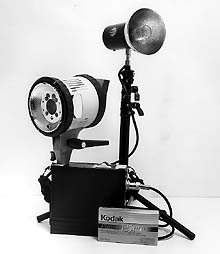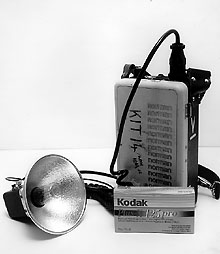
Flash designers have long known these failings and have striven to produce battery versions that matched the features of mains-powered units. These efforts have come from both flashgun and flash lighting manufacturers. Unfortunately, the former have always had to fight on two fronts - attempting to match the power and versatility of mains units whilst also providing the sophistication demanded by modern 35mm SLRs. In addition, there is the matter of keeping prices to affordable levels. The unsurprising reality is that no flash unit can be all things to all people. By the same token, there is indeed a middle ground between flashguns and mains-powered flash lighting, which is occupied by a number of systems - including Hensel's Porty design that is intended for review next month.
Two more direct competitors are the offerings from Lumedyne and Norman. Both are American systems that use similar basic designs, with separate flash head and battery pack units joined by a power cord. The head accepts a sync cable that connects to the camera as usual. If a PC flash socket is provided, the cable plugs-in there. Otherwise, it is necessary to fit a suitable adaptor into the hotshoe and to plug into that. Dedicated operation is not offered, and even automatic exposure is at best limited. But neither Lumedyne's nor Norman's equipment is aimed at those who rely on automatic facilities. Indeed, their primary advantage lies not in out-blasting sophisticated flashguns, but rather in offering the convenience of a flashgun coupled with the flexibility and control of a monobloc.
The 400B/E is claimed to be capable of recycling in 0.3s at its 50J minimum setting and takes only 3s at full power. The maximum number of flashes per charge are 1400 and 175 respectively, with full re-charge possible in just two hours. The complete kit comprises a power-pack with batteries, flash head, charger, standard reflector and carrying strap. The 115/230V multi-standard, voltage stabilised charger plugs into the same socket as the flash head does, and has an in-built fan that cools the unit when in use. Although the head supplied with the kit lacks any modelling facility, there is an alternative that offers this for just �60 more. Usefully, this head is fitted with a timer that prevents the modelling lamp being left on indefinitely (which would risk draining the battery very rapidly indeed). In addition, it is possible to connect a Quantum Q-Flash head, which offers modes more akin to those of a high power camera flashgun. When the standard head and reflector are used, flash durations range from 1/400 to 1/3200, with quoted outputs from 8000bcps to 1000bcps (see box panel explanation of bcps).
Like Norman, Lumedyne offers a 50J minimum power level. Maximum power is 200J on the most basic unit, increasing to 400J, 600J or 800J as boosters are added. As with the Norman, there are both flash-only and flash-with-modelling-lamp heads. There is also an auto-exposure head, but The Flash Centre (Lumedyne's UK distributor) does not push this as it is considered rather expensive. Similarly, a Quantum Q-Flash head can also be fitted. Prices in general are about half KJP's Norman prices, but Lumedyne units do have comparative failings that help to explain the price differences.
Most notable amongst these are the recycling times: without a high speed module, recycling takes between 1.5s and 12s - some considerable way short of the Norman 400 B/E. But if speed is important (and budgets allow), Lumedyne High Speed Modules can be added either singly or in combination to give up to five flashes per second at 50J. Much the same approach applies to recharging times, with only one of Lumedyne's chargers, the Ultra, matching the speed of Norman's standard unit. More positively, Lumedyne has a range of batteries (differing in both weights and capacities), all of which are guaranteed for 70 months with pro-rata credits offered on any that expire before this time.
But perhaps most crucial of all, The Flash Centre has done what no UK distributor of Lumedyne equipment (including, incidentally, KJP at one time), has done before. The Flash Centre offers a compact Elinchrom shell (�100) into which a Lumedyne head can be inserted and onto the front of which standard Elinchrom accessories can be fixed.

Lumedyne 468 outfit with 067X power pack and modelling head. Also shown is the Elinchrom shell into which a Lumedyne head can be fitted to give access to the full range of Elinchrom lighting accessories.
The first things that stand out about the Norman unit are its rounded corners, its upright form and its top-plate location of both controls and the output socket. As such, it is clearly designed for on-shoulder use. In contrast, the Lumedyne has square corners, a lower profile and two side-mounted output sockets, making it better suited to static use. The Lumedyne could well be described as a battery-powered generator flash system, while the Norman is more of a high-capacity battery flashgun. This assertion is supported by the two standard heads: Norman's has an upright design that would suit a camera's flash bracket, whereas Lumedyne's is styled more like a small studio lamp.
Both units were tested as 400J kits with standard reflectors fitted to the heads: the meter readings obtained were the same for each. As expected, the Norman was the faster recycling unit, clocking 4.5s at full power against the Lumedyne's 6.5s.
I can personally vouch for the truth of Lumedyne's pro-rata trade-in offer, having had cause to seek credit for a Lumedyne battery that failed within the seventy-month guaranteed period. Interestingly, every battery is numbered in such a way that its date of supply can be estimated - just in case a user should forget (or under-estimate) its age. And if the identity plate is missing, there may, at The Flash Centre's discretion, be no trade-in value at all!
Although is not really possible to choose a winner between Norman and Lumedyne systems, it would probably be fair to say that the former is the better choice for mobile (on-shoulder) use. The latter wins in terms of overall flexibility. Fortunately, both systems are available on rental, so potential buyers are well placed to try-out the two options before making a final choice. But even in this respect it is swings and roundabouts: KJP's wider network might make the Norman more convenient for more people, but The Flash Centre has an offer whereby half of up to three months' rental fees can be offset against the purchase price for any photographer who rents a Lumedyne kit on trial then subsequently decides to buy. Whichever system is chosen, however, a capable battery-powered flash outfit is likely to prove invaluable to all who those work on location - whether shooting commercial/industrial, weddings, or editorial assignments. Certainly, I wouldn't want to be without mine!
On the other hand, bcps is a measure of actual light output under given conditions. It is not unlike a Guide Number, except that it is better. The problem with Guide Numbers is that they vary depending on the sensitivity of the film used and the distance units in which they are specified. No such vagaries exist when using bcps. As to why they not more widely used, the reasons are almost certainly the daunting (technical) sound of the units on the one hand, and the fact that bcps are relatively meaningless until translated into exposure figures on the other. To convert from bcps to metric Guide Numbers, use the following formula:
GN = 0.075 x sqrt(bcps x ISO)
where "sqrt" means the square root of; and the figure 0.075 should be
replaced by 0.25 if the Guide Number is required in feet.
According to this calculation, the Norman 400B/E has a maximum metric Guide Number (for ISO 100 film) of 67. This makes the unit slightly more powerful than both Metz 60 flashguns and the Bowens Esprit 250 monobloc.

Well-used Norman 400B/E with standard (non-modelling) head, supplied from the hire stock of KJP Drummond Street, London.
Return to Photon August 96 contents